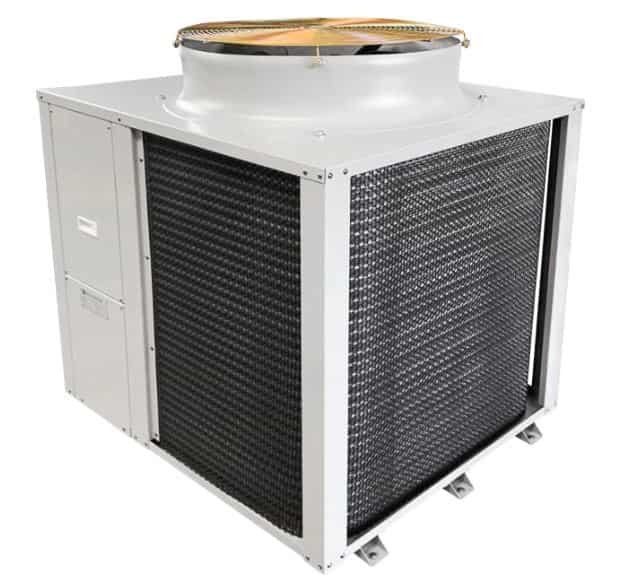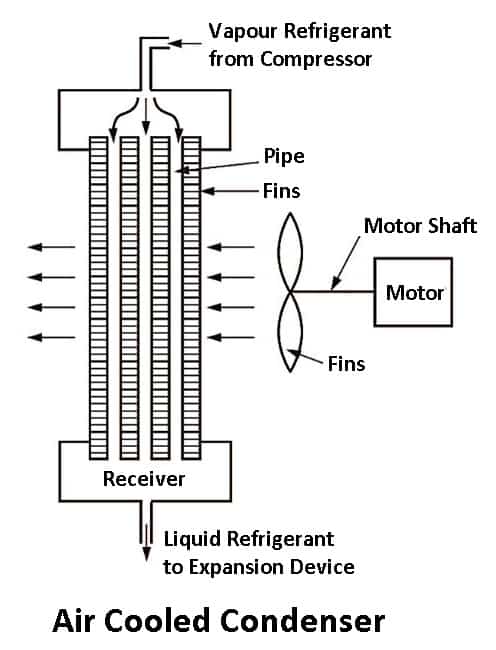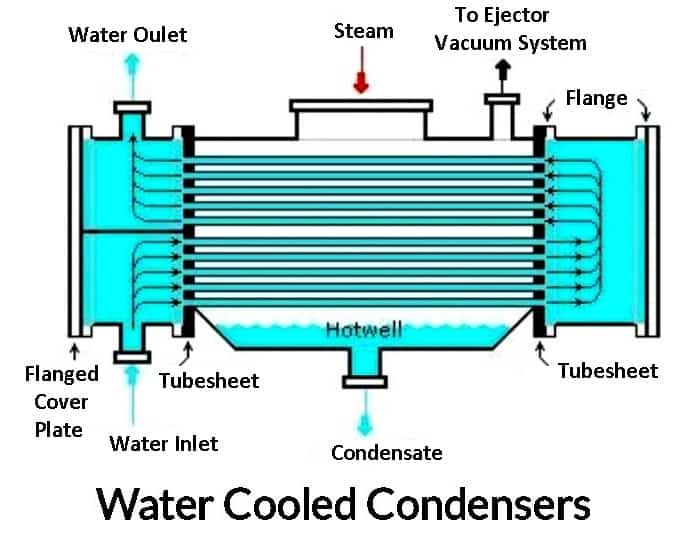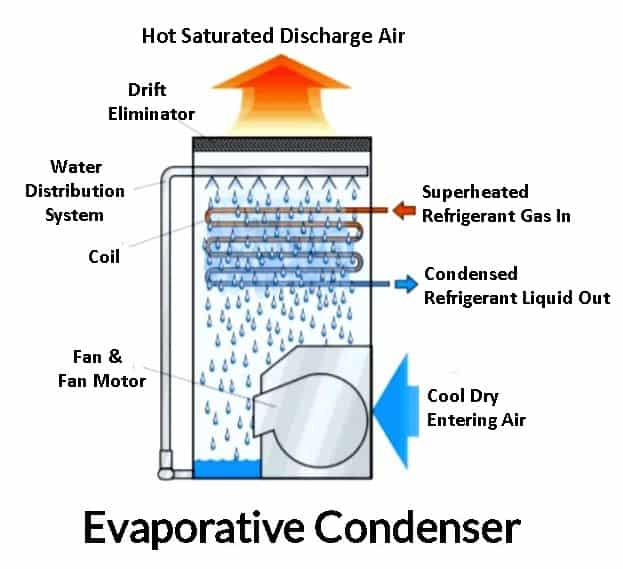Hello readers! In this post, we’ll discuss the different types of condensers and their applications using illustrations.
Simply put, a condenser is a part of the cooling system. The condenser is also called a heat ejector. These are used in every refrigeration system and power plant to condense gases or steam. It converts a subcooled liquid from a superheated and highly pressurized vapor.
What does a condenser actually do? was covered in this article with its Parts, Functions, and Types”. We have gathered helpful information about the various types of condensers. So let’s understand these all.
What is a Condenser?
Condensers are commonly found in general refrigeration systems. Its purpose is to cool the refrigerant that is sent from the compressor. This refrigerant is in a gas state with high temperature and pressure.

The condenser works to cool the refrigerant and condensate it into a liquid. The temperature has dropped, but the pressure remains high. Condenser uses air or water as its primary cooling medium. A condenser’s main components must have good thermal conductivity and corrosion resistance in order to transfer heat.
Condensers are frequently used in the fields of transportation, construction, process, refrigeration, and steam power turbines. Condensers are typically made of copper, brass, aluminum, carbon steel, and stainless steel.
You might like: Air Conditioning System: Diagram, Parts, Working, Types
Working of Condenser
Every condenser goes through three different phases. The initial phase is known as desuperheating. In the evaporator and compressor, the vapor enters the condenser that has already been superheated and super pressurized.
The process of removing heat from vapor and turning it into liquid is known as desuperheating. The next stage is the changing or condensation state; during this stage, more heat is lost as we get to the point where 10% of the refrigerant is in the vapor phase and 90% is in the liquid phase.
A subcooling state characterizes the final and third phases. The sub-cooling state is there to ensure that neither falling temperatures nor even rising ones can turn the liquid refrigerant back into vapor.
Now that you understand how a condenser works. We will now explore types of condensers step by step in the following sections. before that let’s understand the specifications of condensers.
You might like: What is Steam Condenser? How It Does Work?
Specifications of Condensers
A condenser datasheet is a common format for the customer to specify condenser specifications. The manufacturer’s design and selection sheet contains a complete list of the condenser’s standards and specifications.
The following information is typically found in a standard condenser’s specification:
- Condensing Capacity
- Allowable pressure drop
- Coolant or Refrigerant Capacity
- Condenser Material
- Design and Operating Temperature
- Design and Operating Pressure
- Flow rate
You might like: Types of Heat Exchangers & Their Application
Types of Condensers
Following are the main types of condensers and their functions:
- Air-cooled condenser
- Natural convection
- Forced convection
- Water-cooled condenser
- Double tube type
- Shell and coil condenser
- Shell and tube condenser
- Evaporative condenser
Depending on the condensing medium utilized to remove heat from the system, there are three different types of condensers. These three different types of condensers have no specific benefits over one another. Every one of them should be used appropriately depending on the situation.
In the paragraphs that follow, we’ll go into more detail about how these three types of condensers work.
#1 Air-cooled Condenser

This type of condenser uses air as the external fluid that removes heat from the system. It reduces the heat of the refrigerant so that it can condense from a gaseous state into a liquid refrigerant.
Typically, a fin coil is used with this type of condenser to increase surface area and transfer heat away from the refrigerant inside the condenser. Fin coils are typically made of copper tubes and fins. This type is divided into two categories: natural convection and forced convection.
1. Natural Convection
In this type of condenser, air comes into contact with warm coils, absorbing the heat of the refrigerant inside the coils, and as a result, the air temperature rises. Since warm air is lighter, it rises and is replaced by cold air, which again comes in contact with warm coils to reject the heat. This natural cycle is repeated until the refrigerant loses heat.
Since there is little airflow and little heat transfer from radiation, these condensers have a low heat transfer coefficient. As a result, to reject a given amount of heat, a relatively large condensing surface is needed. Therefore, small-capacity refrigeration systems like home refrigerators and freezers use these types of condensers.
2. Forced Convection
Forced convection is another type of condenser. In order to remove heat from the refrigerant inside the coils, a blower or a fan is absolutely essential.
An important point to keep in mind is that the forced convection condenser’s fins are placed closely next to one another; as a result, if dirt and dust get trapped in the tiny space between the fins, the airflow and heat rejection will be greatly restricted.
It is common to find forced convection condensers in window air conditioners, water coolers, and packaged air conditioning systems.
You might like: Different Types of Metals and Their Properties
#2 Water-cooled Condenser

This type of condenser can be referred to as a liquid condenser since it uses water as the fluid to remove heat from the refrigerant. Water-cooled condensers are obviously used where there is an adequate supply of water.
This type is divided into three types, these are described below:
1. Double Tube
In double-tube condensers, a water tube is enclosed by a sizable refrigerant tube. Water absorbs most of the refrigerant heat, but as it is in contact with the natural air circulation, natural convection plays a part in the cooling process.
Double-tube condensers have been used in the past, but their large number of gaskets and flanges complicate maintenance.
2. Shell and Coil Condenser
In a shell-and-coil condenser, a welded shell houses a coil of finned water tubing. This type of water-cooled condenser circulates hot refrigerant in the shell while cooling water cools the coils and condenses the refrigerant. In general, it is inexpensive and portable.
3. Shell and Tube Condenser
These are specific types of condensers that work by rejecting heat through a cylindrical shell made of water tubes. A shell and tube condenser circulates refrigerant in the shell while pumping water through the tubes. Installing fins in pipes improves heat transfer. Shell-and-tube condensers are generally inexpensive and simple to maintain.
#3 The horizontal shell type of shell and tube condensers is the most common. However, vertical shell and tube condensers are typically used with ammonia in large-capacity systems, allowing for top-down tube cleaning while the plant is in operation.
You might like: Different Types of Furnaces and Their Applications
#3 Evaporative Condenser

The evaporative condenser is the last of the different types of condensers. In reality, it combines a condenser with water and air cooling. It is a condenser that combines water- and air-cooling. In evaporative condensers, air and water are used as condensing mediums.
The sump of the condenser pumps water to be sprayed over the coils while a fan blows air into the condenser. The water sprayed onto the coils evaporates, and the heat needed to cause the water to vaporize is obtained from the heat of the refrigerant.
A certain amount of water will be circulated in the sump, but in order to make up for the evaporated water, an additional amount of water will be added to the water supply. In locations where there is a lack of water, evaporative condensers are used. Because water is used in a closed loop, just a small amount of water evaporates.
To cover evaporative loss, makeup water is provided. As compared to an equivalent water-cooled condenser with a cooling tower, the water consumption is typically very low—about 5%. This type of condenser, however, requires longer refrigerant tubing, resulting in larger refrigerant inventories and higher pressure drops, since it is kept outside.
You might like: Different Types of Pumps and Their Applications
Comparison Between These Condensers
The following are the important points that differentiate the condensers:
- Evaporative cooling tends to be less expensive than water cooling, which requires a cooling tower.
- In areas where there is typically a shortage of water, evaporative cooling systems are used.
- Since evaporators are outside, it is necessary to turn off the water pump during the winter to prevent the water from freezing.
Condensers that use air cooling are easier to build than those that use water cooling. In addition, the air is always accessible. When compared to a water-cooled system, an air-cooled system has lower maintenance costs.
Additionally, water-cooled condenser types are more complex than air-cooled condenser types due to design factors for controlling water flow and preventing corrosion. The benefit of water-cooled systems is that heat transfer is more effective because water has a higher exchange coefficient than air.
Selection of Condensers
The choice of a condenser depends on the application and a number of factors, including:
- Full or partial condensing, heat rejection calculation, and condensing capacity
- Type of Industry
- Temperature (Design, operating, Dry bulb, wet bulb)
- Condenser material
- Pressure drop criteria
- Space availability
- Types of condensing medium
- Corrosion
- Fouling factor
Advantages of Condensers
- It improves the efficiency of the plant by increasing the expansion ratio of steam.
- Condenser lessens the steam’s backpressure, allowing for the production of more work.
- It increases work efficiency while lowering the temperature of the exhaust steam.
- The cost of producing electricity is decreased by using condensate as boiler feedwater again.
- The amount of heat supplied per kg of steam is decreased because the condensate is warmer than freshwater.
Disadvantages of Condensers
- Condenser needs enough freshwater supply.
- Condensers are challenging to repair, and corrosion is a problem.
- They take up more space and are more expensive to maintain.
Closing It Up
Understanding the various condenser types allows you to make choices when making your purchase. In this article, we tried to educate you on the various types of condensers, their special uses, and their advantages and disadvantages.
That’s it. Thanks for reading. I hope I have covered everything about the “types of condensers” It would be helpful if you could let me know if there was anything I missed or if you have any doubts about anything I wrote.
Please share this article with your friends if you find it interesting.
Want free PDFs direct to your inbox? Then subscribe to our newsletter.
Download PDF of this article:
You might like to read more in our blog:
- 10 Types of Air Conditioners: How They Work?
- What are Steam Boilers? Its Parts & Working Principle
- Different Types of Boiler Mountings and Accessories
External Links:
Frequently Asked Questions
A condenser’s purpose is to transfer heat from a working fluid—like water in a steam power plant—to another fluid, or even the surrounding air. In this case, the condenser relies on the heat transfer associated with phase changes when a liquid is converted to a vapor.
Condensers are employed in various heat-exchange systems, including air conditioning, steam power plants, and industrial chemical processes like distillation, and distillation. Many condensers use the surrounding air or cooling water as the coolant.
A condenser is a heat exchanger used in heat transfer systems that uses cooling to condense a gaseous substance into a liquid state. By doing this, the substance releases its latent heat and transfers it to the environment.
Condensers for heat pumps and split air conditioners share the same fundamental components. The condenser cabinet houses the condenser coil, a compressor, a fan, and various controls. In order to transfer heat quickly, the condenser coil can be made from copper tubing with aluminum fins or entirely from aluminum tubing.
This pdf is very interested
Thanks for your feedback.
Nice bhai
Thank you.